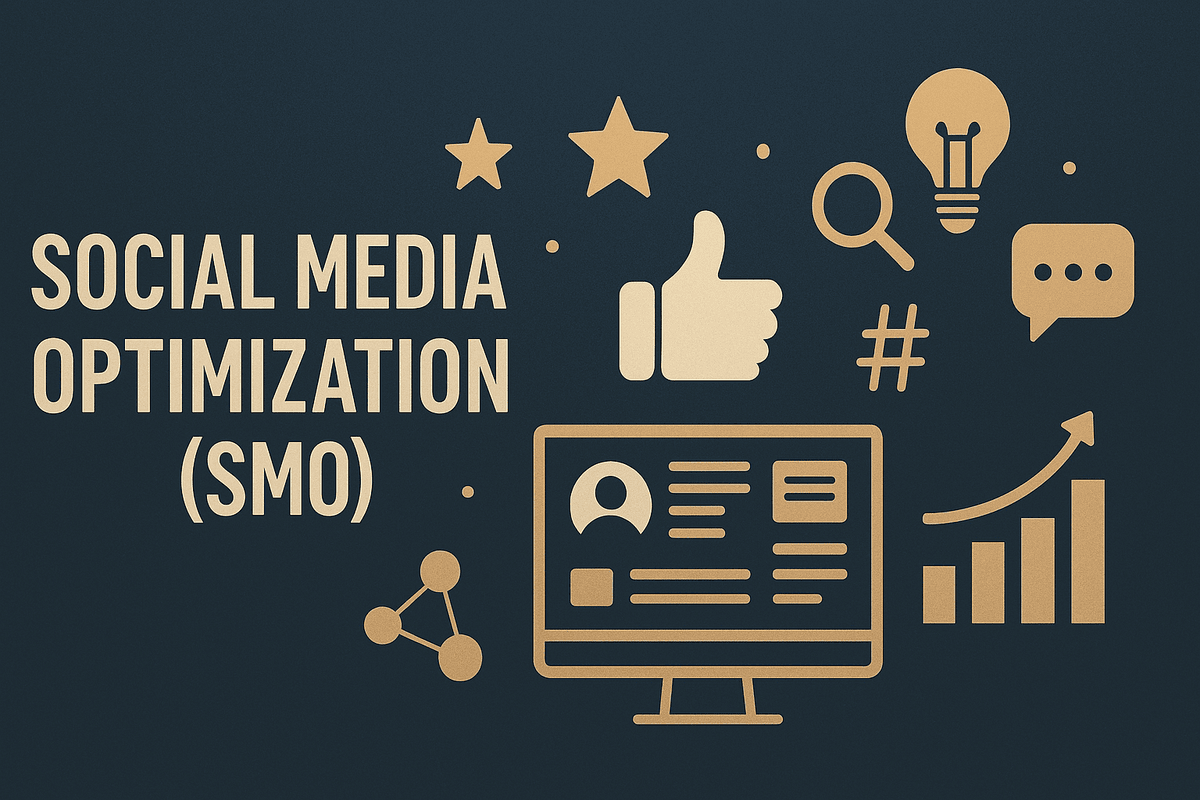Introduction
In today’s digital world, businesses and individuals strive to increase their online presence. Social Media Optimization (SMO) is a powerful strategy that enhances visibility, engagement, and brand awareness. It involves refining and optimizing social media profiles, content, and interactions to drive traffic, improve reach, and establish authority.
With billions of users actively engaging on platforms like Facebook, Instagram, Twitter, LinkedIn, and YouTube, SMO has become an essential component of digital marketing. A well-structured SMO strategy helps brands connect with their target audience, foster relationships, and enhance their reputation.

Understanding SMO
SMO is a process of optimizing social media platforms to maximize a brand’s online visibility. It is closely related to Search Engine Optimization (SEO) but focuses on leveraging social networks to boost engagement and traffic. Effective SMO not only improves social media presence but also strengthens the overall digital footprint of a business.
Key Benefits of SMO
1. Increased Brand Awareness
A well-optimized social media presence helps businesses reach a broader audience. Consistently posting high-quality content, engaging with followers, and using relevant hashtags can significantly boost brand recognition. Additionally, influencer collaborations and user-generated content can enhance credibility.
2. Better Search Engine Rankings
Although SMO doesn’t directly influence search engine rankings like SEO, it plays a role in increasing website traffic, reducing bounce rates, and improving domain authority, all of which contribute to better search engine rankings. When social media pages gain high engagement, search engines recognize this activity as a sign of credibility and authority.
3. Higher Engagement and Customer Interaction
Optimizing social media profiles ensures that content is more appealing and engaging. Encouraging user-generated content, running polls, responding to comments, and utilizing live sessions or Q&A forums enhance user interaction. Engaged users are more likely to trust a brand, leading to increased loyalty and conversions.
4. Improved Website Traffic
Social media platforms serve as powerful traffic sources. Sharing blog posts, articles, and promotional content with engaging captions and call-to-action (CTA) links can drive visitors to your website. Additionally, social media ads and sponsored posts can attract a targeted audience to your website or landing pages.
5. Cost-Effective Marketing Strategy
Unlike traditional advertising, SMO is a budget-friendly approach. Organic reach through engaging content and strategic promotions can generate leads and conversions at a minimal cost. Small businesses and startups can particularly benefit from social media marketing as it allows them to compete with bigger brands without a huge budget.
6. Enhanced Customer Trust and Brand Loyalty
Building trust among your audience is crucial for long-term success. A strong social media presence allows businesses to interact with customers directly, respond to queries, resolve complaints, and provide updates in real-time. Transparency and authenticity in interactions contribute to brand loyalty.
Step-by-Step SMO Strategy Framework
To create an effective SMO strategy, follow these steps:
Step 1: Define Clear Goals
Before implementing an SMO strategy, define specific objectives, such as:
- Increasing brand awareness
- Driving traffic to the website
- Boosting audience engagement
- Generating leads and conversions
- Enhancing customer service through social media
Step 2: Optimize Social Media Profiles
- Use a high-quality profile picture and an eye-catching cover image.
- Write a compelling bio with relevant keywords and brand messaging.
- Include website links, contact details, and CTAs.
- Maintain brand consistency across all platforms.
Step 3: Identify the Right Platforms
Not all platforms are suitable for every business. Choose the ones that align with your audience:
- Facebook: Best for community building, promotions, and advertisements.
- Instagram: Ideal for visual storytelling, influencer collaborations, and reels.
- Twitter: Great for quick updates, news, and audience engagement.
- LinkedIn: Perfect for B2B marketing, professional networking, and thought leadership.
- YouTube: Best for long-form content, educational videos, and product demonstrations.
- Pinterest: Suitable for brands with visually appealing products, DIY content, and infographics.
Step 4: Create and Share Engaging Content
- Use a mix of images, videos, infographics, and text posts.
- Develop informative and shareable content.
- Utilize storytelling techniques for better engagement.
- Maintain consistency in posting and scheduling content in advance.
Step 5: Utilize Hashtags and Keywords Effectively
- Research trending and niche-specific hashtags.
- Include relevant keywords to improve content discoverability.
- Monitor hashtag performance and adjust strategies accordingly.
Step 6: Encourage Social Sharing and Engagement
- Add social sharing buttons to website content.
- Create shareable infographics, memes, and quote posts.
- Host social media contests and giveaways.
- Encourage user-generated content and brand mentions.
Step 7: Leverage Influencer and Community Marketing
- Collaborate with industry influencers to expand reach.
- Participate in relevant groups and communities.
- Engage with followers through comments, polls, and discussions.
Step 8: Utilize Analytics and Improve Strategy
- Track key performance indicators (KPIs) like engagement, reach, and conversions.
- Analyze audience demographics and behavior.
- Adjust content strategies based on data-driven insights.
- Monitor competitors and industry trends for continuous improvement.
Step 9: Invest in Paid Promotions for Better Results
- Run targeted ads to reach specific demographics.
- Use remarketing strategies to re-engage visitors.
- A/B test different ad creatives and formats for optimization.
The Connection Between SMO and SEO
SMO and SEO complement each other. While SEO focuses on optimizing websites for search engines, SMO enhances visibility through social media platforms. Together, they strengthen brand credibility, increase traffic, and improve online authority. High social engagement signals can also boost content rankings on search engines, making SMO an integral part of digital marketing strategies.
Conclusion
Social Media Optimization (SMO) is a crucial digital marketing strategy for brands looking to expand their reach and engagement. By defining clear goals, optimizing profiles, creating engaging content, using strategic hashtags, leveraging analytics, and integrating paid promotions, businesses can achieve higher visibility, increased traffic, and better audience interaction.
A well-structured SMO strategy can set your business apart from competitors and drive sustainable success. Implement these techniques today and watch your brand grow in the digital space!
